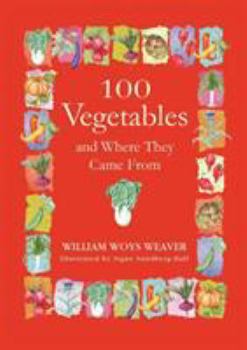100 Vegetables and Where They Came from
Select Format
Select Condition 
Book Overview
A perfect leek from France. Flavorful zucchini from Italy. An infamous potato from Ireland, and a humble lentil from Ethiopia. 100 Vegetables offers a veritable cornucopia of vegetables and stories from around the world--from Argentina to Zimbabwe, from Australia to the United States. William Woys Weaver--veggie connoisseur, gardener, and historian--guides us through a range of peppers, potatoes, peas, gourds, onions, tomatoes, greens, and a whole...
Format:Paperback
Language:English
ISBN:1565122380
ISBN13:9781565122383
Release Date:October 2000
Publisher:Algonquin Books
Length:320 Pages
Weight:0.85 lbs.
Dimensions:0.8" x 5.9" x 8.3"
Customer Reviews
5 ratings
thanks a million!
Published by Thriftbooks.com User , 15 years ago
such a variety of books to choose from and ordering or browsing made stunningly simple. thanks a million!
A travel journal for seeds and vegetables!
Published by Thriftbooks.com User , 23 years ago
This book amazes me: The author has managed to combine two activities I don't usually do (cooking and seed propagation) with two of my least favorite subjects (history and social studies) in a reference-style format compelling enough to read in bed.Mr. Weaver has a flair for culinary description combined with an unabashed enthusiasm for both plants and people. When he describes a plant's origins, he doesn't just state a place and a time, he takes you there, he tells you how he found it, he describes the husbandry behind it, and THEN he tells you what it's like to eat it. And what it goes well with. And how it might look in a garden. And what its virtues are. And so on, invoking an exotic world of color and taste such as never graced your local grocer's vegetable shelves! So: ...If you've ever enjoyed thumbing through cookbooks to savor the taste of imagined dishes......If you've ever enjoyed reading a travel journal and experiencing people and customs through the eyes of others......If you've ever enjoyed browsing through seed catalogs and plotting away the winter with dreams of exotic varieties (--all yours for the mere price of a seed packet!)...Or if your shopping for anyone with an interest in "foodways"......Then this book is well worth the price.
A celebration of our world wide culinary heritage
Published by Thriftbooks.com User , 23 years ago
In one sense this is a popular book, easy to read with helpful line drawings of the vegetables (gracefully rendered by Signe Sundberg-Hall). Weaver even gives phonetic guidance on how to pronounce the names of the vegetables, which include peppers, beans, potatoes, lentils, lettuce, tomatoes, onions, eggplants, etc. Part of the book is a celebration of those names and an appreciation of their history. While reading this I made a mental note to get to my local Whole Foods or Begonia Farms store more often and try something new and exotic!In another sense this is an advanced book for gardeners and culinary experts, not because the book is technical, but because for most people most of the vegetables presented will not be found at the local supermarket, nor will their seeds be found at the local garden and seed store. Additionally it is not always clear to this amateur how these exotic varieties differ from their more prosaic fellows at the local A & P. Weaver helps by attempting to describe the taste (hard to do!) and advises on things like texture, color and spiciness (e.g., wear gloves when cooking Aji Lemón peppers, and don't breath the fumes!). He includes some recipes and advice on complementary foods to go along with the featured veggies. He gives some recipes, sometimes from the culture of origin. For gardeners there are five pages of seed catalogue stores and their web addresses. For botanists he includes the botanical names and the plant's family name. No fungi, by the way. There are varieties from "every continent, except the frozen one," e.g., "Shungiku Edible Chrysanthemum," from Japan, "Pepino Dulce Melon" from South America, "Jaune du Poitou Leek," from France, even the "Petaluma Gold Rush Bean," from my native California. Among the exotic names I found some terminology new to me. Some vegetables are referred to as "heirloom" varieties and/or "cultivars." Weaver uses the term "landrace," which I couldn't find in any of my dictionaries, defined on page two as a noncommercial or "backyard" variety in cultivation for a long time. Weaver has himself cultivated all the varieties presented here on his farm in Pennsylvania where he grows three thousand or so vegetables on a rotating basis. His knowledge about vegetables and his love for them is very impressive. His appreciation of the culinary arts is evident. This is a pretty little book from Algonquin Books of Chapel Hill that would make a nice present for someone you know who loves cooking or gardening.
Excellent folklore for vegetable fans
Published by Thriftbooks.com User , 23 years ago
William Weaver's 100 Vegetables And Where They Came From text picks a hundred vegetables from around the world and shares their stories of development and consumption. Read here about the Pennsylvania Winter Luxury squash which can be eaten like an apple, or the Botswana cowpea, which is a creamy dish in Africa. Excellent folklore for vegetable fans.
Excellent folklore for vegetable fans
Published by Thriftbooks.com User , 23 years ago
100 Vegetables and Where They Came From text treatment of the vegetable picks a hundred vegetables from around the world and shares their stories of development and consumption. Read here about the Pennsylvania Winter Luxury squash which can be eaten like an apple, or the Botswana cowpea, which is a creamy dish in Africa. Excellent folklore for vegetable fans.




